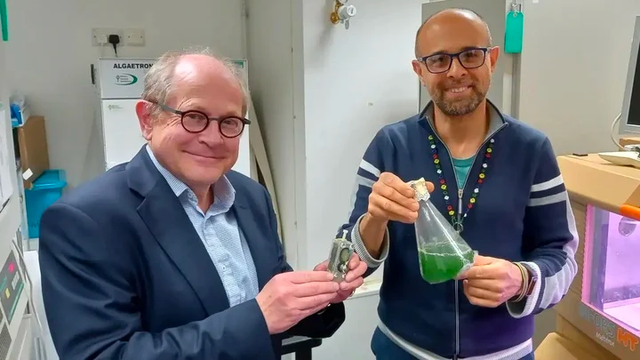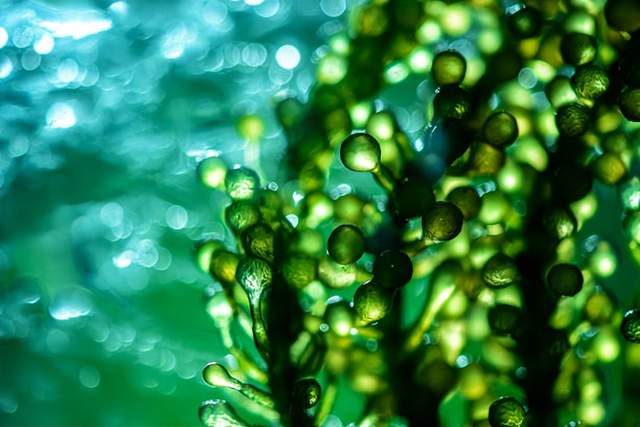Life originated in the ocean. In the ocean, the most basic and primitive unicellular algae is the bottom nutrient in the food chain of marine organisms, supporting the growth of marine organisms and the evolution of life.
Seaweed appeared 3.5 billion years ago, and it is considered a living fossil in the biological world, and it still supports the diversification of the life system of seabed organisms. Seaweed is rich in active ingredients and rich in nutrients, and the conditions for its growth are easy to create, and it only needs water and light to grow happily.
In the development of science and technology, more and more important values of seaweed have been revealed one by one, for example, it is active in functional food, food additives, agricultural breeding, environmental protection and other fields. Recently, a scientific research in which cyanobacteria power generation supports computer microprocessors for a whole year has caused heated discussions in the scientific research circle. The potential power-generating capabilities of cyanobacteria provide a sustainable dawn for the various low-energy IoT devices that are currently pervading the digital world.
Hidden “Power” in Living Fossils
The research was a collaboration between research teams from the University of Cambridge, the University of Milan and ARM, and the related research paper was published in the scientific journal Energy & Environmental Science under the title “Powering a microprocessor by photosynthesis”.
The entire experiment was carried out during the 2021 pandemic lockdown, and the researchers began the study by placing a simple device set on a windowsill. According to the data of the paper, the power generation container used for the experiment is only the size of a No. 5 battery, and the material of the device is also extremely simple, including only four simple basic materials: aluminum, plastic, cyanobacteria, and water.
The research team initially speculated that the principle of cyanobacteria power generation is either that cyanobacteria generate electrons by themselves in the positive and negative electrode settings of the device under photosynthesis, thereby generating electric current, or cyanobacteria create similar traditional electrochemical reaction conditions to convert the cyanobacteria in the container. The aluminum anode corrodes to produce electrons. However, the experimental results showed that the aluminum anode did not degrade and corrode. The team therefore deduced that the cyanobacteria themselves generate most of the current in photosynthesis.

During the experiment from February 2021 to August 2021, the microcomputer powered by cyanobacteria performed some basic operations, calculating the sum of consecutive integers in 45-minute cycles to simulate the computational workload, which cost 0.3 microns. watts of power, 0.24 microwatts of power is required for 15 minutes of standby. The computer will store the measured output current value in the cloud for analysis by the research team.
The original idea of the research team estimated that the system would stop working in a few weeks, but they did not expect that the cyanobacteria could work continuously day and night for 6 months to complete the experiment, and after the experiment, the cyanobacteria continued to generate electricity until now. . In the absence of light at night, cyanobacteria can support the continuous operation of computing systems at night by releasing energy stored during photosynthesis during the day.
We can find that although cyanobacteria have the ability to generate electricity, the amount of electricity released is relatively weak. At present, it is only a systematic verification of cyanobacteria power generation. Corresponding author of the paper C. J. Howe also said: “At this stage, having a cyanobacterial generator on your roof is not going to provide enough power to your house. We still have a lot of research work to do.”
The entire power generation system of cyanobacteria is simple and easy to build. Compared with traditional batteries or solar energy, algae have less impact on the environment and can provide continuous power. The success of this cyanobacteria power generation verification system has also made cyanobacteria power generation, a sustainable, green and low-cost energy method, a possible energy supply method for various sensor devices of the Internet of Things in the future. In some middle-income and low-income remote areas, some groups of people can be provided with low-power mobile phones and sensor devices to supply energy.
Microalgae: the new darling of biofuels
Although the current of cyanobacteria power generation is weak, if the limitations of scale and technology are solved, the energy potential released by cyanobacteria has a very broad prospect in the Internet of Things and the digital world where everything is connected.
We know that IoT devices require a sustainable, low-cost, decentralized source of electrical energy to power them. Although the power consumption of a single IoT device is very low, ranging from microwatts to milliwatts, if all IoT devices are counted, the number has reached billions, and according to statistics, it will increase to 10,000 by 2035. It also means that the energy and material resources consumed behind it are huge. The use of low-polluting, low-cost, sustainable biological resources such as cyanobacteria will also contribute a lot to a low-carbon, sustainable future.
The main biological sources currently utilized by synthetic biology include Escherichia coli, yeast and microalgae. Microalgae have become a highly regarded pedestal biological substrate in the field of synthetic biology due to their species, product diversity, efficient photosynthesis and carbon sequestration ability.
Common microalgae can replace corn and other crops in food processing, feed and other fields. Taking feed protein as an example, according to relevant research, the protein output of microalgae is 4-15 tons per hectare per year, which is much higher than that of wheat and beans per hectare per year. 0.6-1.2 tons of protein yield. Microalgae can alleviate food crises with climate impacts and lack of human resources.
In recent years, microalgae have also become a new favorite for biofuels. Algae can fix carbon dioxide in the atmosphere through photosynthesis, convert it into sugars and plant proteins, and can also generate hydrogen and purify wastewater through reactions. A more environmentally friendly and sustainable energy supply and carbon sequestration method has a strong potential not weaker than other energy sources in all types of clean energy.
Under the joint planning and excavation of policies and technologies, and riding the low-carbon and sustainable east wind, microalgae will also release huge energy in the development process of synthetic biology to realize the main supply of biofuels in the future.
A little more possibility of alien colonization
In the application of microalgae, from carbon sequestration to discharge to food supplementation, it corresponds to environmental protection, energy, and food crises. For organisms, sustainable survival is the goal of life reproduction and evolution. The growth process of microalgae can simultaneously cover and provide a solution to these three developmental challenges.
In the evolution of biotechnology, if the technical limitations and scale problems of microalgae current development are solved, the entire growth of microalgae can be designed in a closed-loop system: microalgae capture atmospheric carbon dioxide under photosynthesis. , converted into proteins and carbohydrate lipids in algal cells, and at the same time can provide electricity and release oxygen.
At present, it is recognized that there are more than 300,000 species of microalgae on the earth, of which 30,000 species are recorded, but only a dozen species of microalgae such as Spirulina and Chlorella have been developed commercially. The entire microalgae industry still has a large market space. According to Credence Research, the global algae products market was valued at $33.9 billion in 2018 and is expected to reach $56.5 billion by 2027, growing at a CAGR of 6.0% from 2019 to 2027. The future 100 billion blue ocean market of microalgae will come under the spotlight and gain more attention from academia, industry and investment circles.
Microalgae have strong tolerance and adaptability. The raw materials required by the closed-loop system are simple, only water and light, without arable land, chemical fertilizers, pesticides and a lot of fresh water, avoiding many common ecological damages, such as deforestation, Biodiversity loss, desertification pollution, etc. The water used in the production of microalgae can also be harvested and reused.
The carbon dioxide fixation efficiency and photosynthesis mechanism of microalgae provide new opportunities and windows for human sustainable development. The current applications of microalgae are mainly in high value-added products, including medical and food fields. For example, the biosynthesis of some microalgae, genetic experiments, the development of algae green sustainable food, etc. In the future, the main focus will be on technological breakthroughs in energy applications, such as power generation and high-efficiency carbon sequestration as mentioned above.
The current research focus of algal technologists in biosynthesis is to break through the technical limitations of synthetic biology, develop new photobioreactor systems, new microalgae scale culture paradigms, release the energy application potential in microalgae, and realize the future as soon as possible Can be produced on a large scale. Microalgae can solve all kinds of crises on the earth, and also have huge commercial space for deep space exploration of the universe.
If the brain hole is bigger, on Mars, a closed-loop system using microalgae can also support part of human activities on Mars. The main gas in Mars’ atmosphere is carbon dioxide, which accounts for 96% of the content. If this closed-loop system of microalgae can be transplanted to Mars, as long as it carries enough water, there is no problem for a small number of researchers to operate on Mars.
Microalgae systems could also support our activities in the solar system if we set our sights on deep space exploration. The gases excreted in our breath are mainly nitrogen, carbon dioxide and oxygen. Among the currently known microalgae, there are more than 70 species that can fix nitrogen. These cyanobacteria release oxygen while fixing nitrogen, which is also a way to support human deep space exploration. Although these set conditions are relatively ideal, the development of science is based on these ideal settings, and there are these rapid changes now, which is also the goal and driving force of future scientific research.
The ancient seaweed with billions of lives has supported and fed countless lives, and has ushered in various era changes in the evolution of the earth. In the modern era of rapid technological change, we can use tools to explore and develop microalgae more deeply. This ancient life will continue to support us to go green, to a sustainable future, and to deep space.




GIPHY App Key not set. Please check settings